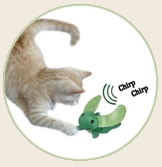| COMMON FACTS ABOUT CATS |
Updated: 25th October 2006 |
| 1. What's the lifespan of a cat? Typically, an indoor cat will live from 15 to 20 years (and more!) Indoors-only cats live longer than cats who remain exclusively outdoors or who travel in and out because of the lower risk of abuse and injuries from traffic, humans, dogs, and other cats. Also, the danger of contracting certain diseases and parasites are lessened when a cat remains inside all the time. 2. How soon can I get my kitten “fixed”? The general answer to that question is 16 weeks, or about 4 months of age. Kittens in shelters get spayed and neutered even earlier (most often just to "get it over with," in case the adopting parent shirks his responsibility.) Earlier spaying and neutering (at the age of 8 weeks) is usually safe and practical; your vet can tell you more about what’s right for your particular kitten. (How can I tell the sex of my kitten?) 3. What should my cat weigh? Just like for people, that depends on gender and bone structure. Common domestic (not purebred) cats probably ought to weigh from 8 to 12 pounds, and a male will weigh about 2 to 4 pounds more than a female. However, if you have a purebred Maine Coon, which is a naturally large cat, 18 pounds would be an acceptable weight. 4. How much water should my cat be drinking? Cats need about a cup of water (8 fluid ounces) per 8 to 10 pounds of body weight. If your cat eats only dry food, you need to be watchful of his fluid intake because his only source of liquid is the water bowl. (Cats who eat canned food get some liquid from their moist meals.) Drinking adequate amounts of water is very helpful in preventing urine crystals, constipation, and hairballs. If you want to promote more water intake, then try putting a few extra water bowls in different places in the house. Keep in mind that domestic cats originated in hot, dry climates (think Egypt and the Middle East), and it isn’t in their nature to take in great quantities of water. Just monitor your cat for any drastic increase or decrease in water consumption; any sudden, dramatic changes are a sign that you need to consult your vet. (If your cat likes running water, take a look at the Drinkwell Pet Fountain.) 5. How much should my cat be eating? 10 pound cat . . . about 250 calories per day 15 pound cat . . . about 300 calories per day 20 pound cat . . . about 325 calories per day Of course, these calorie numbers are rough estimates because every cat is different. Active cats need more calories to fulfill their energy requirements. A cat who is “fixed” needs about 25% fewer calories than an intact cat. Remember, no one knows your cat better than you do. Feed your kitty a sensible amount of food and share some physical playtime every day. (See our great selection of interactive cat toys -- they'll get your cat moving!) If you think your cat is overweight and you want to reduce his food intake, try to make the change gradually over time. Reasons for Vet Visits for Cats: 1. Urinary Tract Infection* 2. Stomach Upset 3. Respiratory Infection 4. Ear Infection 5. Eye Infection 6. Skin Allergy 7. Wound Infection 8. Colitis 9. Gum Disease 10. Kidney Disease AND... For no other reason other than your cat should have twice a year check-ups at the vet. I bet you didn't know that taking your pet to the veterinarian once a year is like you going to the doctor once every seven years. Because cats age so fast they can develop life-threatening diseases in a short amount of time! *Feeding cranberry extract can help with UTI prevention. (See our "Catberry" Treats.) Signs of Feline Diabetes: 1. Excessive Thirst 2. Excessive Urination 3. Excessive Appetite 4. Weight Loss 5. Abnormal gait in rear leg (occasional) If your cat shows signs of feline diabetes you should take the animal to a veterinarian to start on medication or other options. If your cat does not receive treatments to help cure him/her, the animal will essentially starve to death. Signs of Feline Hyperthyroidism: 1. Enlarged Thyroid Gland 2. Thin 3. Hyperactive or difficult to examine 4. Fast heart rate 5. Scraggly hair coat 6. Heart Murmur 7. "Gallop Rhythm" heard when listening to the heart If your feline shows any or all of these symptoms, it should be taken to the veterinarian. Your vet should be able to help your feline get on a path to recovery. |
|
|
 |
It's getting time to bring the outdoors inside. Start  with this squeaking grasshopper. This may look like an average grasshopper, but give it the slightest tap and it will chirp and squeak it way into your cats hearts. 3 1/2"x1 with this squeaking grasshopper. This may look like an average grasshopper, but give it the slightest tap and it will chirp and squeak it way into your cats hearts. 3 1/2"x1 |
